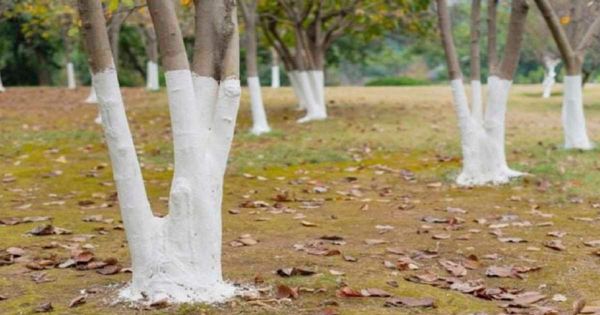One of the wonders of nature is its ever-changing beauty. Each season brings its own vibrant colors, filling us with joy and excitement. From delicate pink blossoms in the spring to vibrant yellow leaves in the fall, nature never fails to captivate us.
But have you ever noticed some trees with white trunks that don’t change with the seasons? Believe it or not, humans are behind this phenomenon – yes, people actually paint these trees! In this article, you’ll explore the intriguing reasons behind painting trees and why it’s done.

Protecting Trees from the Sun’s Harmful Effects
The main reason for painting trees is to protect their trunks from sunscald, which is like a sunburn for plants. Just like how we take precautions against harmful sun rays, trees need protection too. Sunscald can damage the cambium layers of a tree and cause dehydration. By painting the trunks white, the paint acts as a natural sunblock, preventing cracking and damage to the bark.
During the winter months, when temperatures wildly fluctuate between chilly nights and sunny days, the tree bark becomes more vulnerable to splitting. If the bark splits, it becomes an easy target for insects, fungi, and diseases. This is where painting the trunks white during winter becomes essential. The white paint helps to moderate the bark’s temperature and reduces the chances of sunscald injury.
Furthermore, when trees, especially fruit-bearing ones, are exposed to sudden thaws and freezes, they can suffer severe damage. Applying a heavy latex paint or a specially designed formula on the trunk provides an additional layer of protection against harsh winter weather.
Enhancing Visibility and Tree Marking
Apart from protection, another reason for painting trees is to increase their visibility, especially when they are planted near roads. This helps prevent accidents by alerting drivers to the presence of trees.
In forestry, painting tree trunks serves various functions. It can indicate which trees are hazardous or safe, or simply mark private property. In some cases, trees with nests of rare or endangered species are marked to protect them. For example, the federally endangered red-cockaded woodpecker in the Southern United States has its tree nests marked with a white paint ring.
However, it’s important to note that there are no standardized rules for the use of marking paint in forestry. This can lead to confusion when interpreting different symbols and colors. For instance, an X often indicates a tree that should be cut, while numbers may represent a tally before a harvest.
Properly Painting Trees for Optimal Health
If you decide to paint a tree, it’s crucial to do it correctly to ensure the tree’s health. Here are some tips to follow:
- Use water-based latex paint instead of oil-based paint. Oil-based paint can prevent the tree from respirating properly.
- Dilute one gallon of latex paint with four or five quarts of water. This mixture will be safe and effective for tree trunks.
- Look for paint with an organic base to avoid harmful additives that could potentially harm the tree.
- Apply the paint using a paintbrush. Take your time and be meticulous.
- While white is the most commonly used color, if you prefer a different color, choose one that suits your preference. However, avoid using dark shades as they can heat up and harm the tree.
- Typically, painting the trunks once is sufficient. However, if you live in an area with extreme weather conditions, it’s recommended to reapply the paint once a year.
So, the next time you come across a painted tree, remember that it serves not only practical purposes but also adds a touch of uniqueness to our ever-changing natural landscape. Share this fascinating article with your family and friends who might find it interesting. Let’s celebrate the wonders of nature together!





